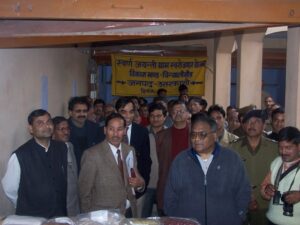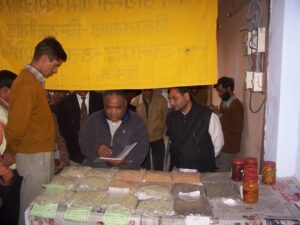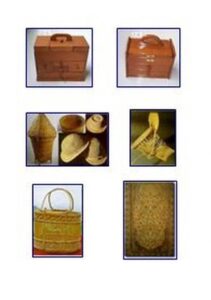GRAMEEN SHILP EMPORIUM PROJECT
MARKETING OF RURAL PRODUCTS IN UTTARAKHAND THROUGH GRAMEEN SHILP EMPORIUMS
INTRODUCTION AND BACKGROUND OF THE PROJECT
The hilly regions of Uttarakhand are known for their exquisite handicrafts and handloom products, specifically in Chamoli, Uttarkashi, Pithoragarh, Bageshwar, and Almora. These districts are famous for manufacturing a wide range of handmade products including woolen shawls, lohies, caps, mufflers, tulma, chutka, woolen carpets, aasan, sofa cushions, stone carvings, engravings on wooden sticks, baskets, mats, bamboo products, rambans products, copper utensils, wall hangings, purses, decorative items, and engraved wooden items. Unfortunately, the handicraft and handloom industry in these hilly regions has been facing several challenges that have led to its decline. One of the primary challenges is the lack of funds for purchasing and processing raw materials. Moreover, the industry also suffers from insufficient technology, tools and equipment, which hinder the production of high-quality and innovative products. Another factor contributing to the decline of the industry is limited production, and marketing challenges, which make it difficult to sell their products.
The decline of the handicraft and handloom industry has had a significant impact on the younger generation, who are forced to migrate to the plains in search of employment opportunities, leaving their female relatives in the villages to struggle for survival. This has resulted in a disconnection from their traditional roots and culture, leading to a loss of heritage and skills. To address these challenges and revitalize the handicraft and handloom industry in the hilly regions of Uttarakhand, a project has been initiated. The aim of the project is to provide financial assistance to the artisans and weavers for the procurement of raw materials and to improve their production processes by providing them with modern technology, tools, and equipment. Additionally, the project seeks to develop innovative designs and products to increase the market demand and promote their products on national and international platforms. Ultimately, the project aims to provide sustainable livelihoods to the artisans and weavers, empower women in the villages, and preserve the rich cultural heritage of the region.
AIMS AND OBJECTIVES OF THE PROJECT
1. Establish a resilient and sustainable market platform that ensures consistent demand and equitable pricing for rural products crafted by household-level producers and artisans.
2. Disseminate pertinent market intelligence to rural producers and artisans, empowering them with essential insights for informed decision-making.
3. Engage in comprehensive research and development (R&D) endeavours aimed at enhancing and modernizing traditional machinery and equipment utilized in rural production.
4. Forge dedicated facilities dedicated to fostering product evolution, design enhancement, and the diversification of rural products, thereby amplifying their competitiveness.
5. Organize curated exhibitions and trade fairs, providing rural producers and artisans with direct avenues to vend their products to potential buyers.
6. Actively participate in both national and international exhibitions and trade fairs to champion rural products, while simultaneously expanding the scope of market outreach.
7. Establish a robust and enduring sales ecosystem and infrastructural framework for rural products, encompassing efficient distribution channels and reliable storage facilities.
8. Administer specialized technical training to elevate the proficiency of rural producers and artisans in realms like product innovation, quality assurance, marketing strategies, and effective business management.
COMPONENTS AND ACTIVITIES OF THE PROJECT
1. Engage in comprehensive baseline surveys and studies to gather essential data about the rural artisan and producer sector, enabling the identification of intervention areas and a deeper understanding of their needs.
2. Establish 20 Grameen Shilp Emporiums and one Central Shilp Emporium as exclusive marketing outlets, offering dedicated spaces for showcasing and selling the creations of rural artisans and producers.
3. Create specialized facilities that encourage product development, design refinement, and product diversification, providing necessary resources and expert guidance to foster innovation and broaden the array of products.
4. Facilitate skill enhancement and knowledge enrichment among rural artisans and producers through well-organized trainings, meetings, workshops, and seminars, fostering knowledge exchange and valuable networking opportunities.
5. Promote skill upgrading and technological integration to enhance the efficiency of traditional machinery and equipment, paving the way for improved operational efficiency and the adoption of innovative practices.
6. Lead research and development initiatives focused on expanding the usage of vegetable and natural dyes in handloom products, exploring eco-friendly dyeing methods to align with sustainable practices.
7. Participate actively in exhibitions and expos organized by both governmental and non-governmental entities to showcase rural products, creating essential connections with potential buyers and stakeholders.
TARGET AREA OF THE PROJECT
The project’s implementation will span across the entirety of Uttarakhand, encompassing all 13 districts, namely Dehradun, Haridwar, Nainital, Almora, Pauri Garhwal, Chamoli, Rudraprayag, Tehri Garhwal, Uttarkashi, Champawat, Bageshwar, Udham Singh Nagar, and Pithoragarh.
TARGET GROUPS AND BENEFICIARIES OF THE PROJECT
The primary beneficiaries of this project are rural artisans and producers who currently reside below the poverty line (BPL). These individuals predominantly engage in traditional handicrafts and handloom weaving, with their livelihoods intricately linked to these time-honoured skills.
FUNDING PARTNER OF THE PROJECT
The project was funded by the Ministry of Rural Development (MoRD), Government of India, New Delhi and the Department of Rural Development (DoRD), Government of Uttarakhand, Dehradun, under the SGSY Special Project Component.
SANCTIONED BUDGET OF THE PROJECT
The project was approved by the Ministry in 2002 under the sanction order No. 24015/52/2001 IRD-V (Sl. No. 31) dated 11.03.2002. The total budget of the project sanctioned for five years, was Rs. 4.82 Crore. Ministry of Rural Development, Government of India contributed Rs. 3,20,25,000.00, while the Department of Rural Development, Government of Uttarakhand provided Rs. 1,06,75,000.00 towards the project. Additionally, credit worth Rs. 55,00,000.00 was arranged from financial institutions to support the project.
OUTCOMES AND ACHIEVEMENTS OF THE PROJECT
The proficient implementation of the Grameen Shilp Emporium Project has yielded significant outcomes and achievements, as outlined below:
1. The establishment of 20 Grameen Shilp Emporiums, alongside a Central Shilp Emporium, stands as a cornerstone achievement. These platforms provide professional marketing channels for rural artisans and producers, offering them the opportunity to showcase and sell their products in a conducive environment.
2. A commendable accomplishment has been the creation of a stable and sustainable market for rural products, originating from the endeavours of rural producers and artisans at the household level.
3. Rural producers and artisans have gained valuable access to market information, technical training, and facilities essential for product development, design enhancement, and diversification. This empowerment has facilitated their growth and innovation.
4. The technological enhancement of traditional production and processing machinery and equipment has yielded tangible results, translating into improved productivity and efficiency for the rural artisans and producers.
5. The project’s dedication to research and development has been evident in the promotion of vegetable and natural dyes in handloom products. This strategic move not only enhances the market appeal of these products but also contributes to the environmental sustainability of rural production.
6. The active participation of rural producers and artisans in exhibitions and expos, organized by both government and non-governmental organizations (NGOs), has been a pivotal achievement. These platforms have not only enabled the showcasing of their products but have also facilitated engagement with potential buyers, thus expanding their market outreach.











